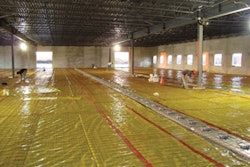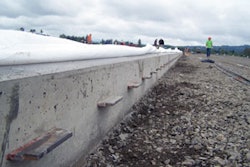
Founded in 1962, Butte Creek Country Club (BCCC) in Chico, CA, is recognized as one of the finest private clubs in northern California. Its pristine 18-hole championship golf course is long, open and well-maintained by mature trees and various nature displays. Golf memberships are limited to 400 to ensure golfers can play when they want. Therefore, country club's board of directors voiced concern when closing the ninth hole was proposed in order to remove an old asphalt cart path and replace it with a new concrete one
Concrete contractor, Cedar Valley Concrete (CVC) in Sacramento, addressed the situation. "We needed a strategic plan to complete the job in four days, without major interference with the golf course's normal operating schedule and keep the area extremely clean throughout the construction process," says Dave Carrick, CVC's regional vice president.
A Challenging Course
BCCC's course is rated at a high degree of difficulty, and pumping the project would be no different. The 2,500-foot golf cart path was long with sharp winding curves. Plus, no access to the course was available for equipment setup.
Therefore, at a planning meeting, it was decided to remove asphalt one day and pump concrete from two staging areas the next two days. From the first staging area, concrete would travel through a delivery line system at a distance of 1,060 feet, with the remainder of the concrete path poured the following day from the second staging area.
Bob Bauman, owner of Bob's Concrete Pumping, Inc. (Bob's) in Chico, CA, was contacted late one afternoon to determine if he had the right equipment to pump concrete through a system that stretched almost a quarter mile, and if he could do it the next day. "It was no problem. I had the perfect pump for the job, but a little more notice would have been nice," Bauman comments.
The machine selected to handle the job was the Putzmeister BSA 120-D trailer-mounted concrete pump, which debuted at World of Concrete 2009. "Since taking delivery in March 2009, the pump has performed well, but it had not been put to any real test prior to this job," Bauman says. "Finally, we would see if this pump model matched the manufacturer's high performance specs on paper."
These specifications include high pressures up to 1,030 psi, high outputs up to 114 cubic yards per hour and a 197-hp Deutz diesel engine. The machine also features a Free Flow Hydraulic system for a smooth, controllable concrete flow.
Unique Foursome
Specifying a mix design was extremely important to effectively pump concrete the distances required without plug-ups, yet still attain a set time requirement of 3,000 psi in 28 days. To meet these specifications, Orland, CA-based Western Ready Mix Concrete Co. (Western) was contacted for its recommendation.
This resulted in a special mix containing four major ingredients, including 1,529 pounds of 1" rock, 1,484 pounds of sand and six sacks of cement. Also added were 16 ounces per cubic yard of V-MAR 3, a new-generation liquid admixture designed to increase the cohesion and stability of extremely high workability concrete. It was used in conjunction with a superplasticiser, ADVA Flow 300, to produce self-compacting concrete, which maintains self-compacting properties while preventing segregation.
To prime the system, Western used 1 cubic yard of four-sack sand slurry to further help prevent plugging.
A True Test
Because the cart path was not a straight line, the delivery line system had to curve with the direction of the meandering pour. Consequently, the crew connected 180 feet of 4" pipe, 680 feet of 4" hose and 200 feet of 3" hose for delivering concrete during the first pour. Ready mix trucks were precisely scheduled 15 minutes apart to prevent any delays.
"This was a private, upscale golf course, and making a mess was not an option," says Justin Gray, the trailer pump operator who worked with five other Bob's employees at the jobsite. "We knew this was not your typical job, so it was important that we worked as a team to ensure everything went as planned."
Unfamiliar with the trailer pump's maximum performance capabilities, the crew was in uncharted territory. "Watching concrete come out of the end of 1,060 feet of system was a sigh of relief to everyone," notes Gray. "The pump performed without any hesitation and exceeded our expectations, as it had plenty of power to spare."
Concrete was placed at a maximum 5" slump. The BSA trailer pump, averaging 32 cubic yards per hour while operating at a 3,700-psi hydraulic pressure, rapidly placed 130 cubic yards of concrete in about four hours for the first pour, which was much faster than planned. More importantly, it was accomplished without closing the ninth hole.
With the first pour making a long successful drive, it was time to test the trailer pump's ability to pump concrete an even farther distance the following day. Adding 120 feet of 3" hose to a similar setup as the day before, the trailer pump placed 156 cubic yards of concrete at a maximum distance of 1,180 feet.
"It was quite a sight to look back from the second staging area to where the cart path started," says Greg Jurgenson, Western's field manager. "You needed binoculars."
Follow Through
"I've been in the concrete pumping business more than 30 years, and this pour went smoother than I could have ever imagined," notes Bauman. "The BSA's long-distance pumping capabilities meant we could quickly and cost-effectively place all the concrete in two days instead of three." The fourth day was reserved for form removal and final cleanup.
As scheduled, the project was completed quickly with minimal disruption to golfers, and the ninth hole was closed only one of the four days (due to tee boxes located right next to the second pour, which caused safety concerns). Plus, the course was left in immaculate condition, with only a new, long-lasting concrete golf cart path as a reminder that construction ever occurred.


















